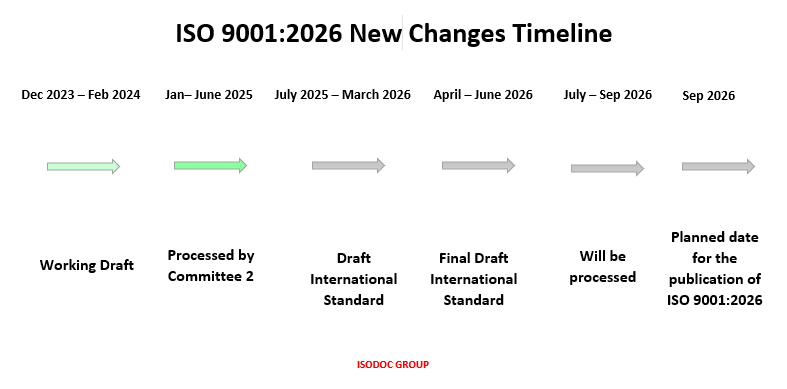ISO 9001:2026 – Key new changes to quality management requirements
Introduction to ISO 9001:2026 Changes
ISO 9001:2026 represents the next major revision of the world’s most widely used Quality Management System (QMS) standard. The update aims to strengthen quality management requirements, align with modern business challenges, and incorporate digitalization, AI, risk-based thinking, sustainability, and customer-focused strategies. Organizations preparing for ISO 9001:2026 certification should understand these key changes, the best time for implementation, and their impact on goods, services, and customer satisfaction.
Key New Changes in ISO 9001:2026
Stronger Integration of Digitalization and AI
Organizations are encouraged to adopt digital tools and artificial intelligence to improve monitoring, decision-making, and continuous improvement, meeting the new ISO 9001:2026 requirements.
Enhanced Risk-Based and Opportunity-Based Thinking
Risk management and opportunity assessment are now more structured. Companies must proactively address supply chain disruptions and global market changes in their QMS.
Sustainability and ESG Considerations
ISO 9001:2026 integrates environmental, social, and governance (ESG) factors, making sustainability a core component of quality management requirements.
Stricter Supplier and Outsourcing Controls
The standard emphasizes supplier oversight, ensuring consistent quality across contractors and outsourced processes.
Customer-Centric Requirements
Organizations must understand evolving customer expectations, implement digital engagement, and measure customer satisfaction effectively.
Knowledge and Competence Management
Expanded requirements for managing organizational knowledge, digital skills, and competence ensure employees can meet the demands of modern QMS practices.
Improved Documentation Flexibility
ISO 9001:2026 allows performance-based documentation, demonstrating the effectiveness of the QMS without excessive paperwork.
Methods to Implement ISO 9001:2026 Changes
Conducting a Gap Analysis
Compare your existing QMS with ISO 9001:2026 requirements, focusing on areas like digitalization, risk assessment, customer engagement, and sustainability reporting.
Strategic Planning
Develop a roadmap for implementation, including milestones for updating policies, processes, and performance indicators. Prioritize digital integration and supplier controls.
Process Redesign and Digitalization
Implement AI-enabled monitoring systems, data analytics, and automated reporting tools to ensure compliance with ISO 9001:2026 requirements.
Employee Training and Competence Development
Train staff on new risk-based approaches, sustainability reporting, and digital tools. Encourage cross-functional knowledge sharing to meet competence requirements.
Pilot Testing and Internal Audits
Test AI-driven monitoring and sustainability tracking systems, and perform internal audits aligned with ISO 9001:2026 draft requirements.
Management Review and Corrective Actions
Update management reviews to include sustainability, digital integration, and customer feedback metrics. Apply corrective and preventive actions for continuous improvement.
Best Time for ISO 9001:2026 Implementation
-
Preparation Stage (Now): Conduct gap analysis and start monitoring draft requirements.
-
Transition Stage (After Publication in 2026): Use the 3-year transition period strategically, starting in the first year.
-
Best Practice: Early adoption gives a competitive advantage by integrating digital tools and sustainability initiatives before others.
Impact on Product and Service Quality
Better Risk Prevention
Reduced production errors and fewer supply chain issues.
Digital Quality Monitoring
Real-time data enables consistent product quality.
Supplier Quality Assurance
Enhanced supplier oversight reduces defects and variations.
Knowledge-Based Improvements
Well-trained employees deliver higher-quality goods and services.
Sustainability Alignment
Environmentally responsible production enhances reliability and long-term value.
Impact on Customer Satisfaction
Improved Trust
Customers recognize the organization’s commitment to sustainability, digitalization, and QMS compliance.
Faster Response to Customer Needs
AI-driven systems enable quick resolution of issues and improved customer service.
Higher Service Consistency
Reduced defects and delays enhance service reliability.
Enhanced Engagement
New feedback mechanisms support continuous improvement based on customer input.
Strengthened Brand Reputation
Certification under ISO 9001:2026 demonstrates leadership in quality management and responsibility.
Conclusion
ISO 9001:2026 introduces key changes to quality management requirements, emphasizing digitalization, risk-based thinking, sustainability, AI, and customer-centric strategies. By adopting structured implementation steps, starting early, and leveraging modern tools, organizations can not only comply with the new standard but also achieve lasting improvements in the quality of products and services and customer satisfaction.

